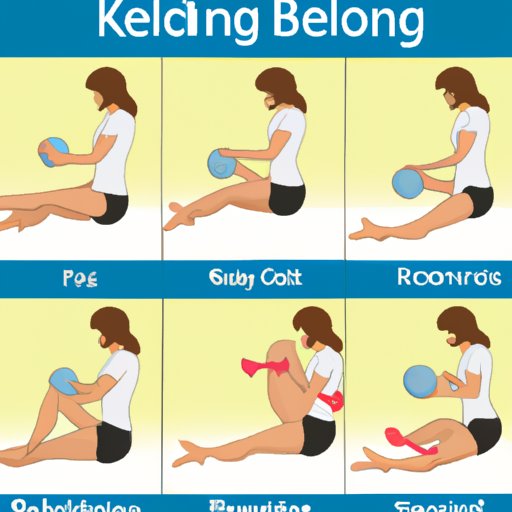Introduction
Kegel exercises are an important part of any man’s health routine. Named after Dr. Arnold Kegel, who first developed them in 1948, these exercises are designed to strengthen the pelvic floor muscles that support the bladder, rectum, and sexual organs. Research has shown that regular Kegel exercises can help improve urinary incontinence, erectile dysfunction, and premature ejaculation, as well as increase sexual pleasure.
Identifying and Locating the Pelvic Floor Muscles
The pelvic floor muscles are located deep within the pelvis and wrap around the rectum, bladder, and sexual organs. To properly identify and locate these muscles, it is important to understand what they do. The pelvic floor muscles help control urination and defecation, support the pelvic organs, and contribute to sexual arousal and orgasm.
To find your pelvic floor muscles, sit or lie down in a comfortable position. Then, try contracting the muscles you would use to stop yourself from passing gas or urine. This should cause a lifting sensation inside the body. If you feel a lifting sensation, you have identified the correct muscles. If not, it is important to seek medical advice to ensure proper identification and location.
Step-by-Step Instructions for Performing Kegels
Once you have correctly identified and located the pelvic floor muscles, you can begin performing Kegel exercises. Here is a step-by-step guide:
Positioning Yourself
Start by finding a comfortable position. You can sit or lie down with your knees bent and feet flat on the floor. Make sure your back is supported and your stomach and chest are relaxed.
Contracting and Relaxing the Muscles
Focus on slowly contracting the pelvic floor muscles. Hold the contraction for three to five seconds, then slowly release. It is important to practice both the contraction and relaxation phases of the exercise.
Repetitions and Sets
Repeat this process 10 to 15 times in a row. This is one set. Gradually work up to performing three sets per day.
Dr. Jan Shifren, a professor of obstetrics, gynecology, and reproductive biology at Harvard Medical School, recommends “trying to squeeze and lift the muscles 10 times in a row, 3 times a day.” She adds that “it helps if you imagine that you’re trying to stop the flow of urine midstream.”1

Different Variations of Kegel Exercises
Once you have mastered the basics of Kegel exercises, there are several variations you can add to your routine to further challenge your pelvic floor muscles. These include:
Isometric Kegels
Isometric Kegels involve holding the contraction for a longer period of time. Start by contracting the pelvic floor muscles and hold the contraction for five seconds. Slowly release and repeat. Gradually work up to holding the contraction for 10 seconds.
Reverse Kegels
Reverse Kegels involve pushing the pelvic floor muscles outwards instead of contracting them. Start by pushing the pelvic floor muscles outward and hold the contraction for three to five seconds. Slowly release and repeat.
Weighted Kegels
Weighted Kegels involve using weights or resistance bands to increase the intensity of the exercise. Start by placing a weight or resistance band on the pelvic floor muscles. Contract the muscles and hold the contraction for three to five seconds. Slowly release and repeat. Gradually increase the weight or resistance as needed.

Tips for Maintaining a Regular Routine
To ensure success with your Kegel exercises, it is important to make them part of your daily routine. Here are some tips to help you stay on track:
Scheduling Time for Kegels
Schedule a specific time each day for your Kegel exercises. Whether it’s first thing in the morning or just before bed, make sure you set aside time for your routine.
Incorporating Kegels into Your Day
To make Kegel exercises more convenient, try incorporating them into your daily activities. For example, you can do them while brushing your teeth, washing dishes, or even sitting in traffic.
Setting Goals
Set realistic goals for yourself and track your progress. According to Dr. Shifren, “It takes about six to eight weeks to really see an effect.”2 Create goals that are achievable and track your progress to stay motivated and see results.
Making Kegel Exercises More Enjoyable
Kegel exercises can be boring and tedious, but there are ways to make them more enjoyable. Here are some tips:
Listening to Music
Put on your favorite tunes and move to the beat while doing your Kegel exercises. Not only will this make the exercises more enjoyable, it will also help you keep a steady rhythm.
Practicing Mindfulness
Mindfulness can help you stay focused and present during your Kegel exercises. Take a few deep breaths and focus on the sensations in your body. This will help you stay mindful and engaged during your routine.
Visualizing the Process
Visualization can help you stay focused and motivated. Before starting your Kegels, take a few moments to visualize the muscles contracting and releasing. This will help you stay focused and connected to the process.

Common Mistakes to Avoid When Doing Kegels
While Kegel exercises are relatively simple, there are some common mistakes that should be avoided. These include:
Not Practicing Good Posture
Good posture is essential for proper Kegel technique. Make sure your back is supported and your stomach and chest are relaxed. Poor posture can lead to improper muscle activation and potentially ineffective exercises.
Overworking the Muscles
It is important to avoid overworking the pelvic floor muscles. Doing too many Kegel exercises can lead to muscle fatigue and soreness. Start slow and gradually work up to more challenging variations.
Not Breathing Properly
Breathing is an important part of any exercise routine. Make sure to breathe deeply and evenly throughout each exercise. Holding your breath can lead to tension and make it difficult to relax the muscles.
Conclusion
Kegel exercises are an important part of any man’s health routine. They can help improve urinary incontinence, erectile dysfunction, and premature ejaculation, as well as increase sexual pleasure. By following the steps outlined in this article, you can learn how to properly identify and locate the pelvic floor muscles and develop a successful Kegel exercise routine. Remember to start slow, focus on proper form, and incorporate different variations as you progress. With dedication and consistency, you can reap the many benefits of Kegel exercises.
(Note: Is this article not meeting your expectations? Do you have knowledge or insights to share? Unlock new opportunities and expand your reach by joining our authors team. Click Registration to join us and share your expertise with our readers.)
